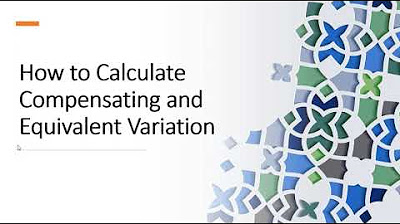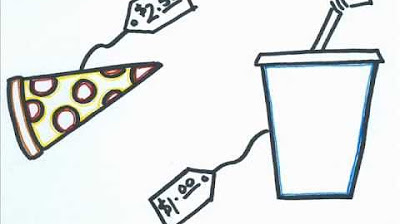How to Derive Indirect Utility and Show Homogeneous of Degree Zero
TLDRThis educational video demonstrates the derivation of an indirect utility function from a quasi-linear utility function. It explains how to calculate the marginal utility of goods and set up utility maximizing conditions, leading to the determination of demand for goods x and y. The video then integrates these demands into the utility function to derive the indirect utility function and proves its homogeneity of degree zero, showing that doubling all prices and income does not alter the utility level, thus maintaining consumer satisfaction.
Takeaways
- 📚 The video discusses the derivation of an indirect utility function from a quasi-linear utility function.
- 🔍 The goal is to prove that the indirect utility function is homogeneous of degree zero, meaning doubling prices and income does not change the utility level.
- 📉 The quasi-linear utility function is defined with income 'm' and prices 'p_x' and 'p_y' for goods x and y, respectively.
- 📝 The consumer's budget constraint is given as income equals the sum of the products of prices and quantities of goods x and y.
- 🔧 The marginal utility of good x is derived by taking the partial derivative of the utility function and simplifying the expression.
- 📈 The marginal utility of good y is simply one, indicating a linear relationship with utility.
- ⚖️ Utility maximizing conditions are set by dividing the marginal utility of good x by its price and doing the same for good y.
- 🔑 The demand for good x is solved by manipulating the utility maximizing conditions and simplifying the resulting equation.
- 🔍 The demand for good y is found by substituting the derived demand for good x into the budget constraint and solving for y.
- 🔗 The indirect utility function is obtained by substituting the derived demands for goods x and y back into the original utility function.
- 🔄 The homogeneity of degree zero is demonstrated by showing that multiplying all prices and income by a factor alpha and then dividing by alpha leaves the utility unchanged.
Q & A
What is the main objective of the video?
-The main objective of the video is to derive an indirect utility function from a quasi-linear utility function and to demonstrate that this derived function is homogeneous of degree zero.
What is a quasi-linear utility function?
-A quasi-linear utility function is a type of utility function where utility is a function of income and other variables, with the utility from income being linear.
What is the consumer's budget constraint represented by?
-The consumer's budget constraint is represented by the equation where money income equals the price of good x times the quantity of good x plus the price of good y times the quantity of good y.
How is the marginal utility of good x derived in the script?
-The marginal utility of good x is derived by taking the partial derivative of the utility function and simplifying the expression to get x to the power of negative one half.
What is the marginal utility of good y in the given utility function?
-The marginal utility of good y is straightforward and is simply one, as given in the script.
What is the utility maximizing condition set up in the script?
-The utility maximizing condition is set up by dividing the marginal utility of good x by its price and doing a similar thing for good y, which is dividing one by the price of good y.
How is the demand for good x derived in the video?
-The demand for good x is derived by solving the utility maximizing condition for x, which involves moving terms around, multiplying through by the price of good x, and simplifying the expression.
What is the process for deriving the demand for good y?
-The demand for good y is derived by plugging the demand for good x into the consumer's budget constraint, simplifying the expression, and solving for y.
How is the indirect utility function obtained?
-The indirect utility function is obtained by plugging the derived demands for good x and good y back into the original utility function and simplifying the expression.
What does it mean for the indirect utility function to be homogeneous of degree zero?
-For the indirect utility function to be homogeneous of degree zero means that if all prices and income are doubled, the utility level remains unchanged, indicating that the function is invariant to scaling.
How is the proof of the indirect utility function being homogeneous of degree zero shown in the video?
-The proof is shown by multiplying each variable in the indirect utility function by a factor alpha, and then demonstrating that after factoring out alpha, the utility remains the same, thus proving homogeneity of degree zero.
Outlines
📚 Introduction to Deriving Indirect Utility Function
This paragraph introduces the video's objective, which is to derive an indirect utility function from a quasi-linear utility function and to demonstrate its homogeneity of degree zero. The concept is explained that doubling all prices and income should not alter the utility level. The quasi-linear utility function is introduced with variables for income (m), price of good x (p_x), and price of good y (p_y), along with the consumer's budget constraint.
🔍 Calculating Marginal Utility and Demand
The paragraph details the process of deriving the marginal utility for good x by taking the partial derivative of the utility function, simplifying the expression to get the demand for good x. A similar process is followed for good y, with the utility maximizing condition setting the ratio of marginal utilities equal to the ratio of prices. The demand for good y is then calculated by substituting the derived demand for good x into the budget constraint and solving for y.
📉 Formulating the Indirect Utility Function
The paragraph explains how to plug the derived demands for goods x and y back into the original utility function to formulate the indirect utility function. Simplifications are made to the expression to arrive at the final form of the indirect utility function, which is a crucial step in understanding consumer behavior under different price and income scenarios.
🔄 Proving Homogeneity of Degree Zero
The final paragraph focuses on proving that the derived indirect utility function is homogeneous of degree zero. This is demonstrated by multiplying all prices and income by a factor (alpha) and showing that the utility level remains unchanged, as the factor cancels out, thus confirming the homogeneity property of the indirect utility function.
Mindmap
Keywords
💡Indirect Utility Function
💡Quasi-Linear Utility Function
💡Homogeneity
💡Marginal Utility
💡Budget Constraint
💡Demand Function
💡Price Ratio
💡Utility Maximization
💡Consumer's Choice
💡Income Effect
💡Substitution Effect
Highlights
The video aims to derive an indirect utility function from a quasi-linear utility function.
The indirect utility function will be shown to be homogeneous of degree zero.
Doubling all prices and income will leave the utility level unchanged.
The quasi-linear utility function is introduced with income 'm' and prices 'p_x' and 'p_y'.
The consumer's budget constraint is defined in terms of income and prices of goods x and y.
The marginal utility of good x is derived by taking the partial derivative of the utility function.
The marginal utility of good y is simply one.
Utility maximizing conditions are set up by dividing the marginal utility of goods by their respective prices.
The demand for good x is derived by solving the utility maximizing condition for x.
The demand for good y is obtained by plugging the demand for good x into the budget constraint.
The indirect utility function is formed by substituting the derived demands for goods x and y into the utility function.
The indirect utility function simplifies to a form that can be analyzed for homogeneity.
The indirect utility function's homogeneity of degree zero is demonstrated by multiplying all prices and income by a factor 'alpha'.
The utility remains the same even after doubling all prices and income, confirming the homogeneity property.
The video concludes by summarizing the findings and the
Transcripts
Browse More Related Video

Derivation of Hicksian Demand Function from Utility Function

How to Calculate Compensating Variation and Equivalent Variation

Episode 18: Consumer Equilibrium

Consumer Welfare: Compensating Variation & Equivalent Variation

Mathematically Solving for the Income and Substitution Effect of a Price Change

Marginal Analysis and Consumer Choice- Micro Topic 1.6
5.0 / 5 (0 votes)
Thanks for rating: